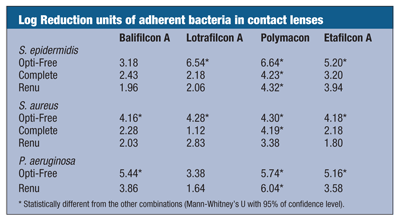 Despite the development of new lens materials, the incidence of inflammatory and infectious keratitis has not been reduced. However, studies have shown that new hydrogel wearers have a lower incidence of inflammatory and infectious events. It has been suggested that perhaps some formulations of multipurpose disinfection solutions (MPDS) are not compatible with certain lens materials, which may be associated with corneal staining, ocular discomfort, inflammatory events and lens dropout.1-4
Despite the development of new lens materials, the incidence of inflammatory and infectious keratitis has not been reduced. However, studies have shown that new hydrogel wearers have a lower incidence of inflammatory and infectious events. It has been suggested that perhaps some formulations of multipurpose disinfection solutions (MPDS) are not compatible with certain lens materials, which may be associated with corneal staining, ocular discomfort, inflammatory events and lens dropout.1-4
The Role of MPDS
The ability of an MPDS to disinfect is ultimately based on the complex interactions of many components, including biocidal susceptibility of the challenge organism, the presence or absence of tear film components, uptake and release of the biocide from the lens material (including the size of the lens material pores and/or the size of the biocide molecule) and the concentration of the biocide in solution through evaporation or topping off.5
A recent study looked at the level of disinfection of MPDS solutions and lens materials.5 Although previous literature suggested biocidal sequestration within the lens matrix would reduce the efficacy of the disinfection system, Lívia Santos, M.Sc., and colleagues at the Institute for Biotechnology and Biological Engineering, University of Minho in Braga, Portugal, quantified the disinfection for various combinations of materials and solutions.3,6-9
Biocide uptake and release in a lens material is regulated by the electrostatic attraction when the material has an opposite charge to the biocide and by the hydrophobicity of either the biocide or the lens material.3 The FDA groups for contact lens materials were developed to categorize lens material behavior with different care products. Lenses in Group 3 and Group 4 of the FDA lens material classifications are ionic in nature. Electrostatic attraction occurs when the anionic nature of the lens material interacts with the cationic domains of the biocide.
 Due to their hydrophobic nature, silicone hydrogel lenses attract the non-polar heads of the biocides and sequester them in the material. This happens in order to lower the high surface tension at the solution-material interface and is therefore a much stronger force in hydrophobic silicone than established by hydrophilic surfaces.4
Due to their hydrophobic nature, silicone hydrogel lenses attract the non-polar heads of the biocides and sequester them in the material. This happens in order to lower the high surface tension at the solution-material interface and is therefore a much stronger force in hydrophobic silicone than established by hydrophilic surfaces.4
It would make sense then that anionic material with large pores would have more biocidal uptake. Conversely, nonionic, hydrophilic hydrogel materials, which have small pore sizes, would have minimal biocide uptake. Contact lens solutions containing larger molecules, such as polyquad, have less propensity for uptake.4 Therefore, nonionic, hydrophilic materials in conjunction with polyquad-based disinfecting solutions should have maximum disinfection. Indeed, Dr. Santos’ study showed that Polymacon (FDA Group 1) uniformly gave better log unit reduction than other lens types, for a given solution.4
Other factors including the concentration of the biocide and dual disinfection systems will ameliorate the biocidal ability.
Further study is needed on lens solution properties and resultant disinfection capabilities; however, perhaps as we understand these interactions better, we can use this knowledge to pair lenses and solutions to reduce the chances of developing adverse events.
1. Carnt NA, Evans V, Naduvilath TJ, et al. Contact lens-related adverse events and the silicone hydrogel lenses and daily wear care systems used. Arch Opthalmol. 2009 Dec;127(12):1616-23.
2. Jones L, MacDougall N, Sorbara LG. Asymptomatic corneal staining associated with the use of balafilcon silicon-hydrogel contact lenses disinfected with a polyaminopropyl biguanide-preserved care regimen. Optom Vis Sci. 2002 Dec;79(12):753-61.
3. Andrasko G, Ryen K. Corneal stinging and comfort observed with traditional and silicone hydrogel lenses and multipurpose solution combinations. Optometry. 2008 Aug;79(8):444-54.
4. Santos L, Oliveira R, Oliveira ME, Azeredoa J. Lens material and formulation of multipurpose solutions affects contact lens disinfection. Cont Lens Anterior Eye. 2011 Aug;34(4):179-82.
5. Fleiszig SM, Evans DJ. Pathogenesis of contact lens-associated microbial keratitis. Optom Vis Sci. 2010 Apr;87(4):225-32.
6. Rosenthal R, Dassanayake NL, Sclitzer RL, et al. Biocide uptake in contact lenses and loss of fungicidal activity during storage of contact lenses. Eye Contact Lens. 2006 Dec;32(6):262-6.
7. Sentell KB, Beaullieu E. Comparison of preservative uptake and release profiles of PHMB from soft contact lenses case products by silicone hydrogel contact lenses. Invest Ophthalmol Vis Sci. 2004;45:1573.
8. Dannelly HK, Waworuntu RV. Effectiveness of contact lens disinfectants after lens storage. Eye Contact Lens. 2004 Jul;30(3):163-5.
9. Powell CH, Lally JM, Hoong LD, Huth SW. Lipophilic versus hydrodynamic modes of uptake and release by contact lenses of active entities used in multipurpose solutions. Cont Lens Anterior Eye. 2010 Feb;33(1):9-18.


